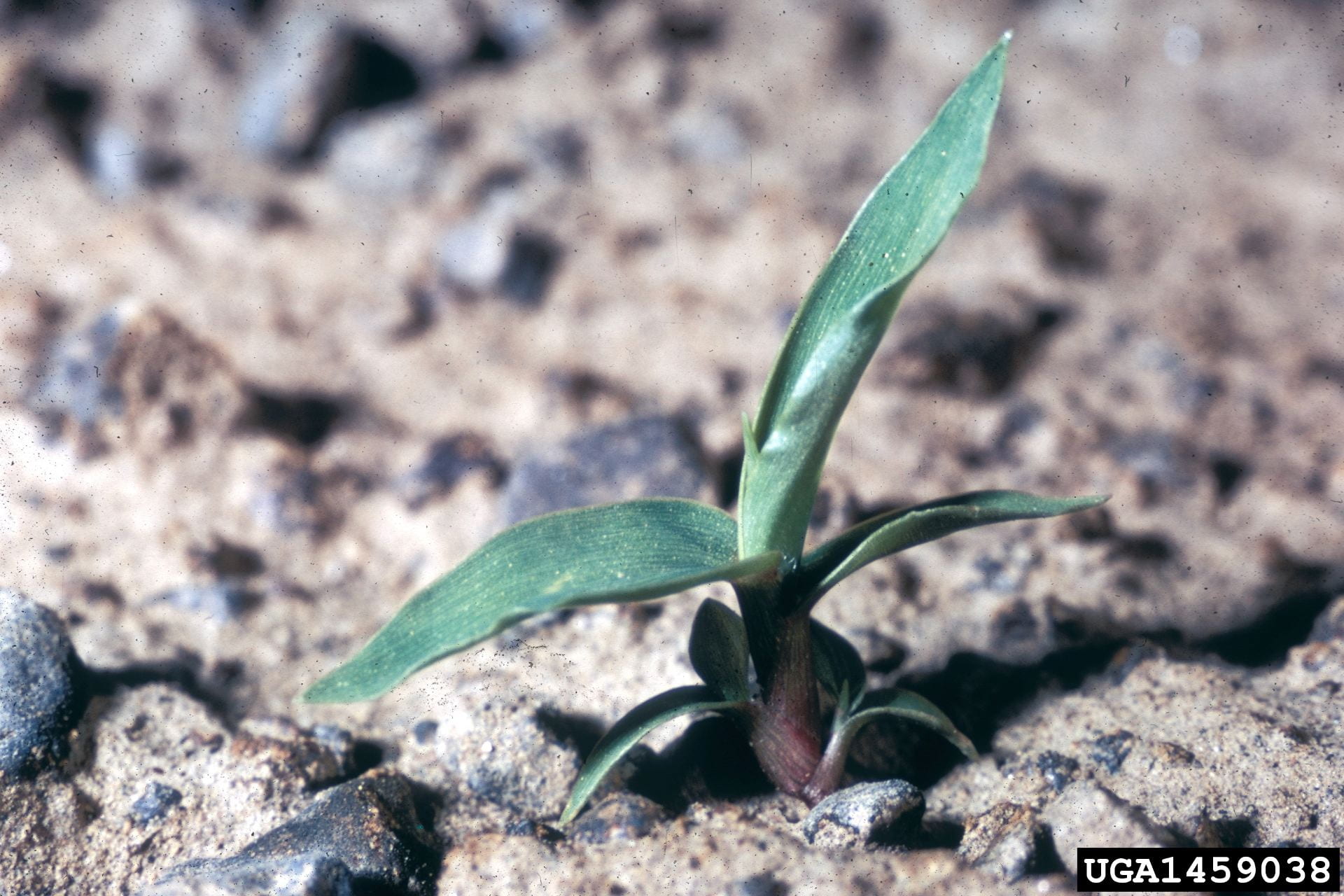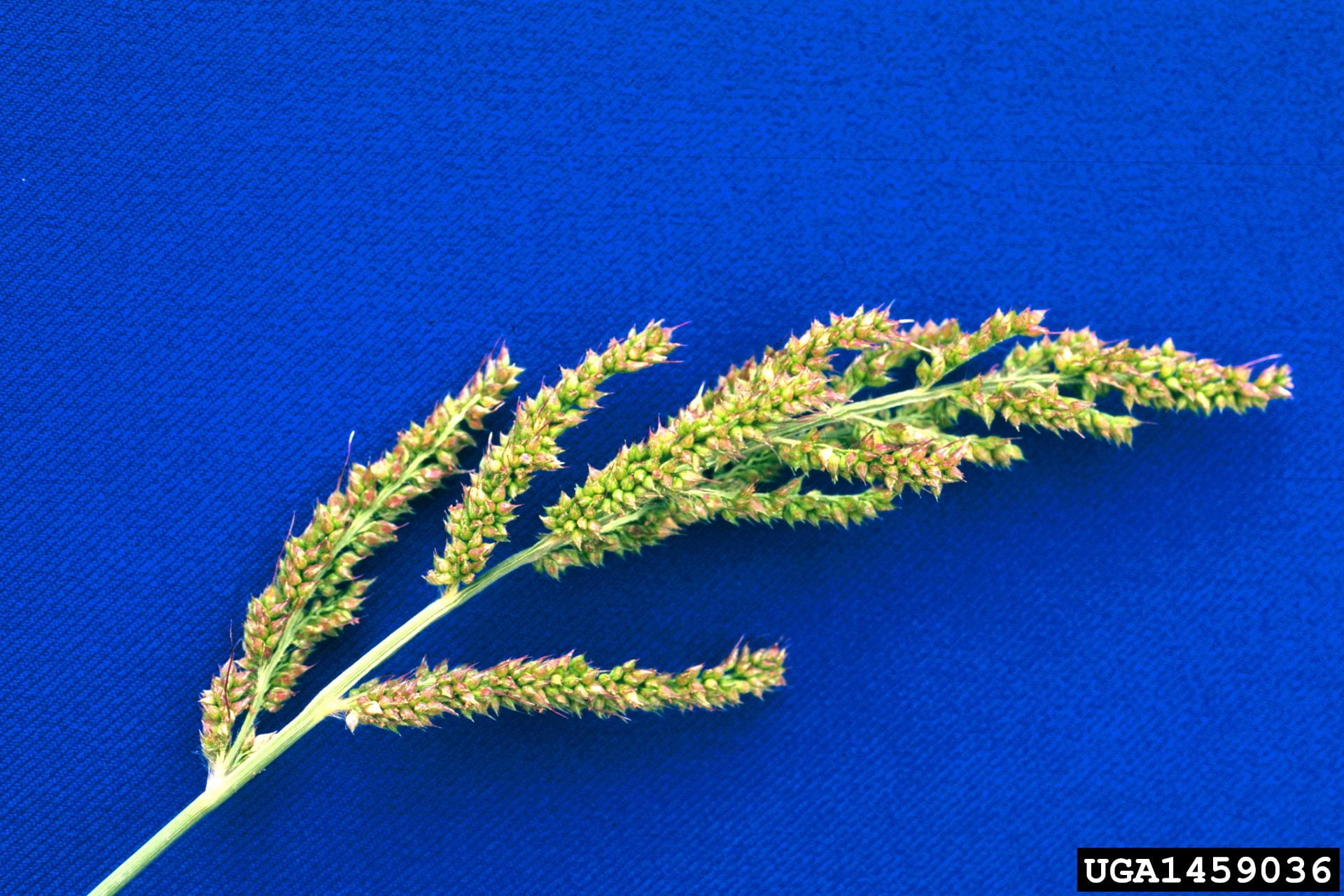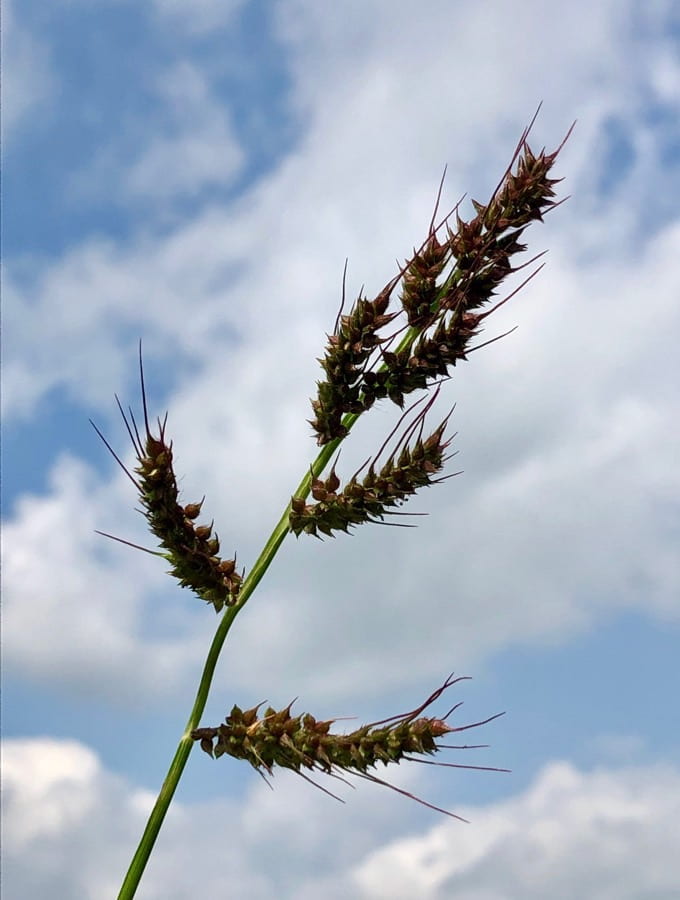Barnyardgrass (Echinochloa crus-galli) is a summer annual grass found throughout much of the North America. It is a common weed in New York berry, vegetable, and field crop systems.
Identification
Seedlings: First leaves are hairlesss and have no membranes/hairs (ligule) or ear-like projections (auricles) at the base of the leaf – just a flat, whitish collar with no additional hairs or membranes. This is one of our only weedy grasses with this trait. Leaves are rolled (leaf bud) when they emerge rather than folded, are hairless, and often have some maroon tinging towards the base of the plant. The midrib is distinct and lighter than the rest of the leaf, and sticks out below the leaf a bit towards the base of the leaf (keeled).
Leaves: On the mature plant, leaves are rolled up rather than folded, and they lack ear-like projections (auricles) or membranes/hairs (ligule) at the leaf base. Leaves are hairless except for a few hairs at the base of the leaf, and are about 10-20cm (4-8″) long and 5-20 mm ( up to 3/4″) wide.
Flowers/Fruit: Barnyardgrass has a distinctively bulky flowering/seeding head, with close-set spikes of flowers set that grow in a herringbone pattern. Both the flowers and seeds appear chunky, rather than the feathery look of most grass heads. Flowers are bristly, tiny, and green to purple, sometimes with a long bristle from the tip (awn). Seeds are shiny, tan to brown, and oval.
Management
Chemical control
Cornell University’s Turfgrass and Landscape Weed ID app offers suggestions for conventional and alternative chemical control options.. For general guidance on weed control, get the latest edition of the Cornell Crop and Pest Management Guidelines.
Non-chemical control
As barnyard grass seeds are only moderately persistent, rotation with perennial forage crops can reduce density. As barnyard grass germinates in warm environments, another effective approach is rotating with winter grains, which are more established and more competitive when barnyard grass emerges.
For crops planted when the soil is warm and moist, a false seedbed approach (leaving two weeks between tillage and fitting to flush weed seeds) can be effective. For crops planted in late spring and summer, freqiemt cultivation close to the row is helpful. Another approach would be a dense application of organic mulch early in the season, to keep the soil cool and discourage germination.
Solarization with clear plastic for 40 days is another option, as it kills barnyard grass seeds in the top 3 cm of soil.
The fungal pathogen Exserohilum monoceras has demonstrated some effectiveness against barnyardgrass.
Herbicide resistance
Reported as of 2021:
North America
U.S.
Groups 2 (1 state), 4 (2 states), 7 (4 states), 13 (1 state)
2-way multiple resistance to groups 1 and 8 (CA)
4-way multiple resistance to groups 1, 2, 7, and 26 (MS)
Other continents
Africa
Group 1 (Egypt)
Asia
Groups 1, 2, 4, 7, 8, and 15
2-way multiple resistance to groups 7 and 15 (Philippines)
2-way multiple resistance to groups 1 and 2 (South Korea)
2-way multiple resistance to groups 7 and 15 (Thailand)
Australia
Group 1 (New South Wales)
Europe
Groups 2, 3, 5, 7
2-way multiple resistance to groups 1 and 2 (Italy)
2-way multiple resistance to groups 1 and 2 (Turkey)
South America
Group 9 (Argentina)
4-way multiple resistance to groups 1, 2, 4, and 26 (Brazil)
For a more detailed report, please see the reference section below or visit the International Herbicide-Resistant Weed Database homepage for more information on resistance.
Similar species
Table 1: Shows barnyardgrass (Echinochloa crus-galli) similarities and differences in identification compared to its similar species: johnsongrass (Sorghum halepense) and fall panicum (Panicum dichtomiflorum).
| Species | Barnyardgrass (Echinochloa crus-gallis) | Johnsongrass (Sorghum halepense) | Fall panicum (Panicum dichtomiflorum) |
|---|---|---|---|
| Similarities | Smooth to rough leaf blades; sheaths smooth | Coarse-textured foliage and may look similar to barnyardgrass at maturity; sheaths smooth | Coarse-textured foliage and may look similar to barnyardgrass at maturity; sheaths smooth |
| Differences | Ligule: absent | Ligule: membranous | Ligule: fringe of hairs |
References
Uva R H, Neal J C, DiTomaso J M. 1997. Weeds of the Northeast. Book published by Cornell University, Ithaca NY. The go-to for weed ID in the Northeast; look for a new edition sometime in 2019.
Cornell University’s Turfgrass and Landscape Weed ID app. Identification and control options for weeds common to turf, agriculture, and gardens in New York; uses a very simple decision tree to identify your weed.
Organic management suggestions are from Dr. Charles Mohler of Cornell University. Look for an upcoming book from Dr. Mohler on ecological management of weeds, from Cornell University Press.
PennState Extension’s webpage on Control of Summer Annual Grass Weeds in Turfgrasses. Offers descriptions of cultural and chemical control methods.
Pennsylvania State University’s Center for Turfgrass Science: Barnyardgrass. Has a nice video on identification by seedheads.
University of Missouri’s Weed ID Guide: Barnyardgrass.
Great Lakes Aquatic Nonindigenous Species Information System’s webpage on information regarding Barnyardgrass. Includes descriptions of barnyardgrass identification, ecological impact, and management.
Images included from Invasive.org. Offers an extensive online library of images for invasive and exotic species of North America.
Image also included from flickr.com.
Detailed herbicide resistance
Currently reported resistance:
North America
South East: Mississippi, groups 1, 2, 7, 26 (fenoxaprop-ethyl, imazamox, imazethapyr, propanil, and quinclorac (MOA in monocots)); Louisiana, groups 2 (imazethapyr), 4 (quinclorac), and 7 (propanil); Arkansas, groups 4 (quinclorac), 7 (propanil), and 13 (clomazone)
Mid-West: Missouri, group 7 (propanil)
South West: Texas, group 7 (propanil)
Mid-Atlantic: Maryland, group 5 (atrazine, cyanazine, and simazine)
West (CA): multiple resistance to groups 1 and 8 (cyhalofop-butyl, fenoxaprop-ethyl, molinate, and thiobencarb/benthiocarb)
Canada, in the province of Ontario: group 5 (atrazine)
Other continents
Africa: Egypt, group 1 (fenoxaprop-ethyl)
Asia: China, groups 1 (fenoxaprop-ethyl, and quizalofop-ethyl), 2 (penoxsulam), 4 (quinclorac), 8 (thiobencarb/benthiocarb), and 15 (butachlor); Japan, group 1 (cyhalofop-butyl) ; Philippines, multiple resistance to groups 7 and 15 (butachlor, and propanil); South Korea, multiple resistance to groups 1 and 2 (azimsulfuron, bensulfuron-methyl, bispyribac-sodium, cyhalofop-butyl, fenoxaprop-ethyl, flucetosulfuron, halosulfuron-methyl, imazosulfuron, metamifop, pyrazosulfuron-ethyl, pyribenzoxim, and pyriminobac-methyl); Sri Lanka, group 7 (propanil); Thailand, multiple resistance to groups 7 and 15 (butachlor, and propanil) and additionally group 1 (cyhalofop-butyl, fenoxaprop-ethyl, and quizalofop-ethyl)
Australia: New South Wales, group 1 (cyhalofop-butyl, and profoxydim)
Europe: Bulgaria, group 3 (pendimethalin); Czech Republic, group 5 (atrazine); France, groups 2 (foramsulfuron, and penoxsulam) and 5 (atrazine); Germany, group 2 (nicosulfuron); Greece, group 7 (propanil); Italy, multiple resistance to groups 1 and 2 (azimsulfuron, bispyribac-sodium, cyhalofop-butyl, imazamox, penoxsulam, and profoxydim); Poland, group 5 (atrazine); Spain, groups 2 (nicosulfuron) and 5 (atrazine); Turkey, multiple resistance to groups 1 and 2 (bispyribac-sodium, cyhalofop-butyl, and penoxsulam); Ukraine, group 2 (imazamox, imazapyr, nicosulfuron, and penoxsulam)
South America: Argentina, group 9 (glyphosate); Brazil, multiple resistance to groups 1, 2, 4, 26 (bispyribac-sodium, imazethapyr, penoxsulam, cyhalofop-butyl, penoxsulam, and quinclorac (MOA in monocots))









